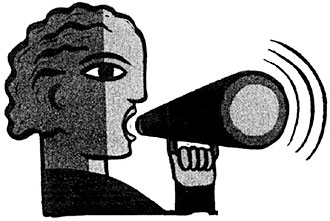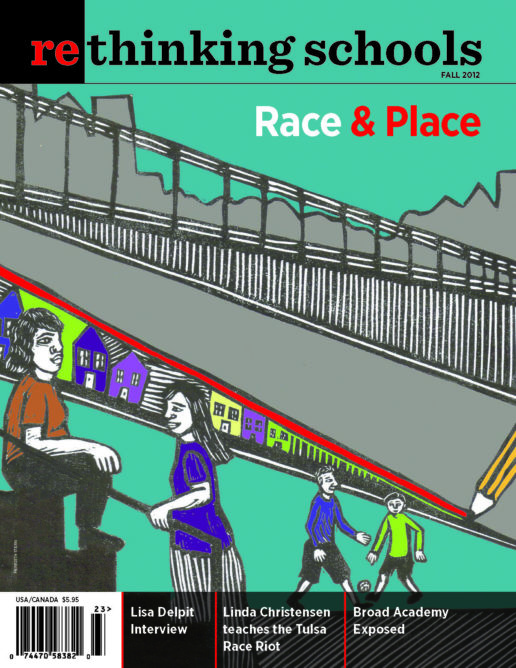Saving Mango Street
Illustrator: radicalgraphics.org

St. Helens, Oregon, is a rural town about 30 minutes northwest of Portland; it was all I’d ever known. I was used to the flannels and work boots and the fact that most kids’ dads worked at the mill. I wasn’t allowed to play at a friend’s house after I told my mom that my friend’s stepdad wouldn’t let us in his shed because he was growing funny plants. I shopped at Target for school clothes when we took a rare trip to Portland. Almost everyone I knew was working-class and white.
I first learned about cultural diversity and racial justice in Mr. Sanderson’s middle school English class. Sure, we learned about grammar and literary concepts, but Sanderson opened our eyes—or at least my eyes—to the fact that the world was different outside of St. Helens. We read a book called The House on Mango Street by Sandra Cisneros and learned about a different culture, but also about a community with striking similarities to our own.
The main character in the novel, Esperanza, a 13-year-old Chicana, grows up in an impoverished neighborhood in Chicago. Mexican American culture and themes of social class and gender are interwoven through the novel’s vignettes. I could relate to living in a poor area with a short supply of opportunity. And, like Esperanza, I realized how important it was to remember my roots and to give back to the community from which I came.
Banned from Middle School
Last year, the St. Helens school board decided to ban The House on Mango Street from the middle-school curriculum. The district’s “reconsideration committee” claimed that the book contained “content too mature for this age group” and expressed “concerns for the social issues presented.”
Charles Sanderson contacted me, informing me that the school district had temporarily pulled the book and asking if I could help. First I was angry. Then I was razzed up and ready. But I had doubts. Who was I, some college student, to go up against an entire school district and tell them what they were doing was wrong?
I wrote a letter about how The House on Mango Street affected me. The school board could debunk my other arguments, but they could never tell me what I did or did not feel, what I had or had not learned from this book and our discussions in class. The House on Mango Street changed me. Cisneros’ writing style inspired me to create a series of my own vignettes dealing with my parents’ divorce. I learned to heal through the power of writing. Engaging in the classroom discussions about Esperanza and her life introduced new perspectives and ideas. It made me think; it made me realize that there is more to the world than the insular community I was living in.
I knew I wouldn’t be the only one up.set about the threat to Mango Street. But how could I assemble a group of protesters when I now lived more than 100 miles away from my hometown? I called an old friend from high school who was known for being strong-willed and possessing a get-it-done attitude: Sam Chapman, also a former student of Sanderson’s. I felt better having Sam on my side.
After discussing the issue with Sam, I posted a status on Facebook, asking former and current St. Helens students if they remembered reading The House on Mango Street, telling them what was happening, asking what impact the book had on them. We got an overwhelming response: “Why would they pull that? It’s such a good book!” “How is that fair?” “They don’t have the right!”
Fifty-nine comments later, I decided to ask former students to write short testimonials about how they had benefited from having Mango Street in their middle school curriculum.
The 10 well-documented testimonials we received covered a range of subject matter and emotion. Arthur Truong, a 2010 graduate, wrote:
[Cisneros] consciously identifies and discusses the presence of Latin American communities, homeless people, and independent women. . . . As a student of ethnic identity, this message was incredibly important. . . . I can understand that you may be worried that by bringing up these social issues in the book, students will treat each other differently. But that’s a good thing. By bringing up this kind of social context from a different point of view, students learn about different perspectives in life and how to respect them.
The Mango Street Army
We didn’t stop at high school graduates. When I was a junior in high school, I volunteered at the middle school as Sanderson’s teaching assistant. I’ve always been into writing, so he let me create my own writing workshop for a group of 8th graders. Now they were high school seniors. I created a group on Facebook called “The Mango Street Army” and added all the high school seniors I knew. I told them about the situation and asked them to get in contact with classmates.
Sam suggested I call the curriculum director to get clarification as to why The House on Mango Street was being banned: Exactly which social issues were they worried about? What was a “reconsideration committee”? Which policy had they used to pull the book?
The curriculum director brusquely referred me to the school board’s website to look up the policy. Because of her abrasive response, I sent in my letter and received an emailed reply the next day from a school board member. He thanked me for expressing concern and informed me of a school board meeting the following week and told me how we could speak publicly. Sam and I marked the date.
Speaking Up, Speaking Out
The night before the meeting, I compiled the testimonials into one document. We also had two full-length letters from the Mango Street Army. I made copies to give to the school board members, and prepared what I was going to say.
I was nervous before I spoke at the school board meeting. I worried that I’d look like a fool. But I thought of the papers in my hand, and the stories I was going to share, apart from my own:
I took away a feeling of identification with myself. I saw the girl struggling with her own identity and trying to find meaning for herself in the neighborhood that she grew up in. . . .
I personally come from a conservative, Christian home. This novel was indeed appropriate for my peers and me. It opened my eyes to issues that I wish were discussed more often in school. . . .
I stepped up to the microphone and, with shaking hands, pulled my letter up to read. I made eye contact with each board member and tried to keep my voice from shaking. I explained that banning Mango Street was not going to preserve the innocence of students and the importance of teaching diversity in our community.
Then Sam read an anonymous student’s story from the testimonial sheet:
There are many life lessons in The House on Mango Street, but there is one that helped change me forever although, at the time, I didn’t realize I would later become a victim of sexual assault like Esperanza. My junior year I was raped. Back while Mr. Sanderson was teaching this book in my class, some guy stated that it is a woman’s fault for being sexually assaulted and raped. Mr. Sanderson was infuriated at this, and I will never forget his reaction. He was yelling, but the next day he wrote us an apology letter in class and explained why he felt the way he did and he said something along the lines of “If a woman says no, it can never be her fault.” . . . Esperanza dreams of leaving Mango Street and her problems behind. She discovered that you can’t run from your problems. . . . This book has affected me greatly and I wish I would have absorbed the lessons more at the time. I believe this would be a terrible decision on St. Helens’ part if they stopped teaching the lessons of this book.
Sam argued that banning a book that speaks directly about experiences like this one promotes silence. It encourages silence for victims of sexual assault, for those subjected to and hurting from racism, and for those with other real-world problems that need to be discussed.
We both received applause as we said our thank-yous and sat down. The curriculum director gave a short presentation on the board’s policy system. A school board member asked her not to discuss anything related to The House on Mango Street because it was not on the agenda. Members of the audience called out, “Why?”
Making Things Right
Finally, the superintendent spoke, saying that since the issue was already on the table, he would read a formal statement. The statement said that, after review of the reconsideration committee’s proposal to pull the book from the middle school curriculum, and after receiving multiple emails and expressions of concern, he had decided not to accept the proposal. He said he would review and amend the rules for the reconsideration committee’s membership, function, and power to regulate curriculum based on content complaints.
The crowd applauded, and Sam and I got pats on the back and congratulations.
In these times, schools need to expand students’ thoughts concerning major life issues; we need course materials that honestly address race, culture, sexuality, violence, and resistance. We shouldn’t have to defend our right to learn about the world—the real world, not a protected world of make-believe that some adults want to present to students. I learned that organized action is sometimes necessary. Sanderson may or may not have intended this, but his class taught me one of the most fundamental lessons of all: When I spot injustice, I need to try to make things right.

